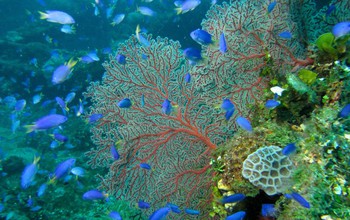All Images
Research News
Parasites: Rulers of the Reef

"Despite the negative connotation of the word parasite, parasites enjoy the world's most successful lifestyle," says Paul Sikkel. "In fact, parasites account for the majority of inhabitants of coral reefs, which are the world's most diverse ecosystems. To truly understand coral reefs and how they will be impacted by environmental change, we must understand their parasites."
Credit: Dan Norton, Coral.org
Download the high-resolution JPG version of the image. (1.1 MB)
Use your mouse to right-click (Mac users may need to Ctrl-click) the link above and choose the option that will save the file or target to your computer.

A green gnathiid isopod collected from a fish at Lizard Island Great Barrier Reef. Gnathiids are unusual because they only feed as larvae, and the only thing they eat is blood. Adults don't feed at all.
Credit: P. Sikkel, Arkansas State University
Download the high-resolution JPG version of the image. (1.2 MB)
Use your mouse to right-click (Mac users may need to Ctrl-click) the link above and choose the option that will save the file or target to your computer.

Even though the oceans occupy the majority of the planet, scientists know far less about environmental factors that cause disease transmission in oceans than on land. Sikkel found evidence that longfin damselfish, such as this one pictured here, are infected by blood parasites, implicating gnathiids as possible disease spreaders.
Credit: P. Sikkel, Arkansas State University
Download the high-resolution JPG version of the image. (131.5 KB)
Use your mouse to right-click (Mac users may need to Ctrl-click) the link above and choose the option that will save the file or target to your computer.
Marine biologist Paul Sikkel discusses the important role of parasites in coral reef ecosystems.
Credit: NSF
Download the high-resolution PNG version of the image. (350.4 KB)
Use your mouse to right-click (Mac users may need to Ctrl-click) the link above and choose the option that will save the file or target to your computer.


